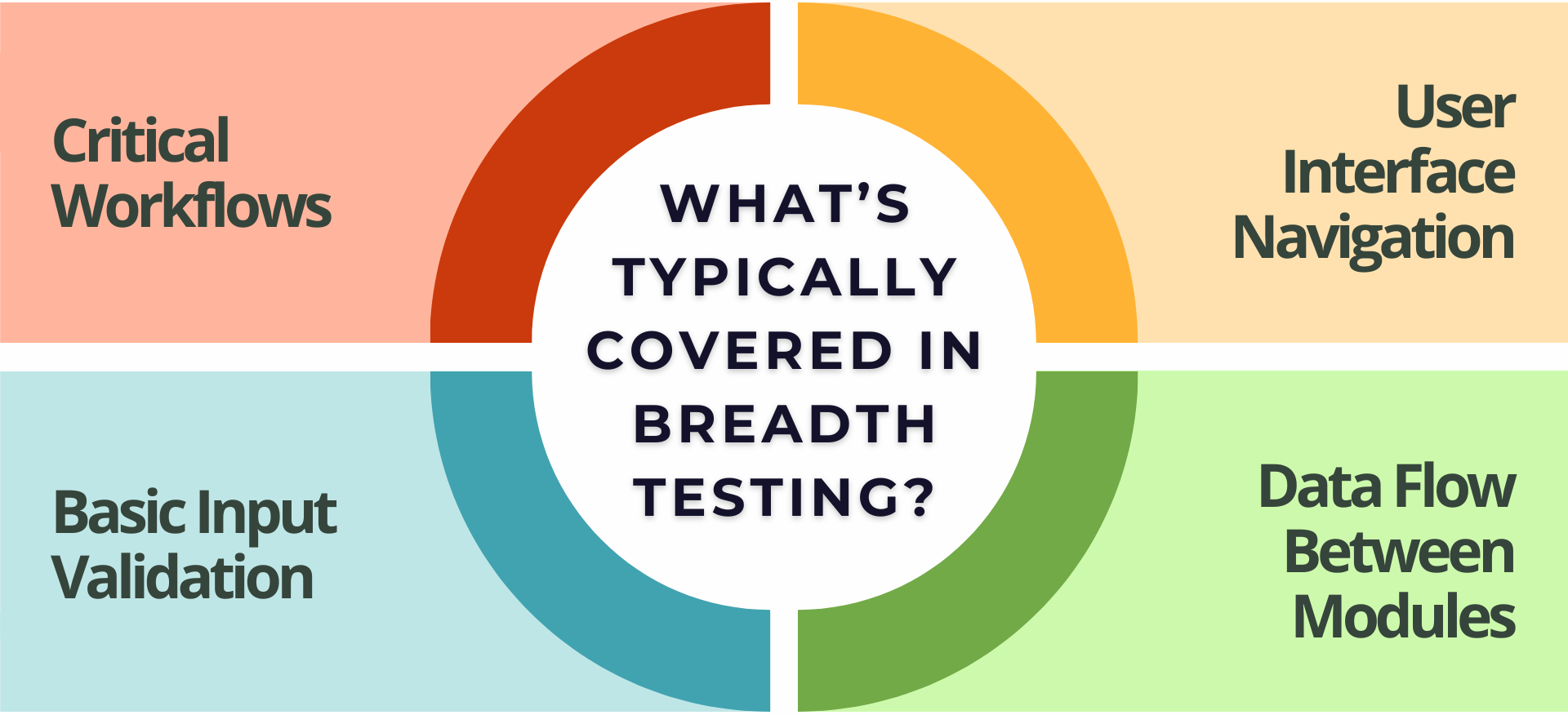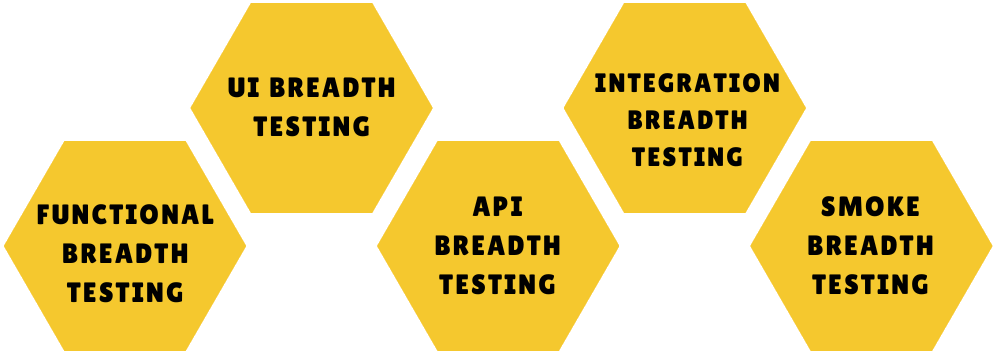What is Breadth Testing?
|
|
Breadth testing is one of the important concepts in the field of testing and quality assurance. This concept can be poorly understood and poorly utilized, but it’s a fundamental idea that helps to ensure that a software application will behave correctly through every feature, even if not all features are tested through and through. In this extensive guide, we will see what breadth testing is, why it is done, and what benefits it brings, how are you contributing and ensuring higher quality products in the market, how best to use it, most used tools, real-world use cases, what can go wrong, and what’s best ongoing.
Key Takeaways:
- Breadth Testing ensures your application’s major features function by covering them at a high level without going deep.
- It helps identify integration issues and cross-functional bugs early in the software development lifecycle.
- Breadth testing is best used after builds, during CI/CD pipelines, or pre-release to catch major blockers quickly.
- Automating breadth tests provides fast, reliable feedback and helps scale quality checks across teams.
- To maximize product quality, breadth testing should be used alongside more detailed functional and regression testing.
What is Breadth Testing?
It is a concept of Quality Assurance which aims at initially validating the overall functionality of a certain software application throughout almost all of its features, without narrowing down to deep validation in specific areas. The ultimate aim is to end up with nearly every big piece banged up and validated at a high level.
It gives a full system-level view to identify integration and cross-functional issues early, as opposed to thorough checks on individual modules. In breadth testing, the following are tested: the major functionalities of an application, use of various services, submittal of forms, field validation, cookie support, menu hierarchy, etc. Similarly, several items are part of the tested application’s scope and are termed breadth tests.
Main Goals of Breadth Testing
Breadth testing is designed to provide wide but shallow coverage of an application. It doesn’t dive into each feature’s inner workings but ensures that no important area is left untouched. Here’s what that means in detail:
- Touch Every Major Feature: Breadth testing verifies that the major areas/modules/features in the application are accessed and a handful of validations occur. It is a sanity check that the minimal feature set works and that the software has not been crippled somehow during build or upgrade.
- Catch Early Integration Issues: This ensures that the application’s various components and services can work together. By traversing multiple parts of the system over workflows, breadth testing can trap early data-interchange or action-triggering issues.
- Identify Cross-Module Errors: Breadth testing uncovers bugs that manifest only when modules are utilized together in a real-world case. These are the things that get overlooked in isolated unit tests and only become obvious when you actually navigate through the app.
- Reduce Risk of Major Gaps: This goal is to make sure no important area of the application is left completely untested. It minimizes the chance of deploying software with major oversights or missing functionalities due to lack of coverage.
What’s Typically Covered in Breadth Testing?

Breadth testing makes sure that all the major functionalities of an application are covered without going deeper into the test cases to verify it. The following are the major things that come under breadth testing:
Critical Workflows
These are minimal end-to-end user stories that show how user interacts with the system. For example, usecases like logging in, accessing a dashboard and running a report can be used to verify if the core functionalities of the application are working properly. Teams can rapidly find out if one major process is breaking or blocked by validating these workflows.
User Interface Navigation
UI Testing verifies that the user interface behaves as expected, for example: you make sure that pages and screens load correctly and that the elements (such as buttons, menus, and links) are clickable and display and that the navigation is working as expected. It tests whether or not the users can navigate through the application without errors or dead links. This sort of UI validation provides a more uniform and accessible user experience.
Basic Input Validation
These involve basic checks, like input accepting and processing data as expected when you type an email address or submit a form. With breadth testing, you are checking that basic validation rules are enforced, such as required fields and patterns (e.g., “[email protected]”). It also serves to avoid trivial, mistaken input from interfering with the user’s workflow.
Data Flow Between Modules
This ensures that data flows properly throughout different application pieces, for example, data travelling from a registration form to a user profile module. Breadth testing ensures that what is entered or changed in one module is correctly reflected in other related modules, hence maintaining the integrity of data. For instance, if a user changes their phone number in their profile, it should be reflected appropriately in the billing or contact sections.
When to Use Breadth Testing
Use breadth testing when you are looking for fast, high-level validation of the entire application. It will help you catch major problems before you dive into good test coverage. Some common scenarios where breadth testing is required include:
- After First Pass Builds are Deployed to a Test Environment: When a new build gets pushed out to the QA or staging environments, Breadth testing helps us prevent any big ticket features from “falling over” and not being accessible in some way. This serves as a first checkpoint to discover broken links, missing pages, or a botched early setup.
- Pre-Release Validation to Ensure Nothing Is Entirely Broken: Breadth testing offers one last sanity check before rolling out a release and going live. It ensures important features remain working and stops major regression from reaching end users.
- Regression Testing to Quickly Check All Areas After Changes: When any new changes or fixes are added, Breadth testing provides a quick way to ensure other parts of the app that were not catered for have not been inadvertently broken. It is a convenient way to receive a broad education with minimal time. Read: What is Regression Testing?
- CI/CD Pipelines to Run Fast Sanity Checks: In CI/CD environments, breadth tests can be automated to follow each build. These fast sanity checks are useful because they can stop show-stopper bugs early and prevent bad code from going downstream.
- Post-Integration Milestones to Verify Module Integration: After merging multiple components or services, Breadth testing helps validate that integration points are functional and that data flows properly between newly connected modules. This ensures high system cohesion.
- Agile Sprints to Validate Overall Sprint Deliverables: At the conclusion of each sprint, breadth testing validates that all new features are in place and able to be utilized. It instills confidence among stakeholders that sprint goals were achieved without the need for deep, time-consuming testing.
Types of Breadth Testing

There are different forms of Breadth Testing depending on the testing and testing objectives. These pretty much guarantee that various parts of the application are not checked, but are pretty good at catching what’s low-hanging fruit. Here are the most common types:
Functional Breadth Testing
This type of testing validates that all core functional areas of the application are working at a surface level. Testers briefly check features like user registration, login, search, and checkout flows without going into edge cases or deep logic. The goal is to confirm that key functions are accessible and behave as expected. Read more: Functional Testing Types: An In-Depth Look.
UI Breadth Testing
This makes certain that your screens, layouts, and interactive elements such as buttons, links, forms, and menus all work as they were meant to. It also checks for simple alignments and responsiveness and loads pages. This one provides a nice visual and browsing health check of the front end of your application. Read: UI Testing: What You Need to Know to Get Started.
API Breadth Testing
In this type, testers ensure that crucial api endpoints are accessible and respond with the expected basic responses (e.g. HTTP 200 OK, simple json responses). It can be used to test connectivity and reachability towards backends, but should never test real business logic. This helps to catch problems such as broken endpoints or misconfigured routes early on. Read more: API Testing.
Integration Breadth Testing
This aims to ensure that modules communicate the right way. For example, it verifies that user input on the front end is being stored in the database properly and that reports or other services use the stored data properly. It works at a high level and ensures data and control flow between components. Read more: Integration Testing: Definition, Types, Tools, and Best Practices.
Smoke Testing as Breadth Testing
They are a form of breadth testing used to verify the stability of a software build. These tests can quickly verify that the most important functionality works, such as the app’s start, logging in, and loading the dashboard. Once the smoke test fails, no more tests are run, so it’s an important initial validation step. Read: What is Smoke Testing in Software QA?
Advantages and Limitations of Breadth Testing
| Advantages | Limitations |
|---|---|
|
|
Breadth Testing in SDLC Phases
The value of breadth testing is not confined to the testing phase, it can be very useful throughout the whole SDLC. Teams can be confident in breadth coverage, early defect detection, and release quality by baking in breadth testing across all phases.
- Requirement Phase: In this phase, breadth testing is used for confirming and establishing a complete list of major functionalities and modules, and there were no omissions in the list.
- Design Phase: During design it makes sure that all modules that are supposed to be covered are somehow part of the test strategy, on which it is then possible in the parallel to build up optimal coverage.
- Development Phase: Developers can use breadth testing for quick sanity testing to ensure that the core functionality works and nothing is broken by checking if the new code works with current code. Read: Smoke Testing vs. Sanity Testing.
- Testing Phase: Breadth testing is a front line for regression or exploratory testing, allowing QA teams to assure the system’s shallow stability. Read: How to Automate Exploratory Testing with AI in testRigor.
- Deployment Phase: On the verge of release, breadth testing is used to verify that essential flows perform as expected and that the app is ready to go into production.
Breadth Testing Strategy Design
Developing a good breadth testing strategy will also help plan how to achieve high-level coverage in an efficient and reliable way. The following procedure is the way to take a disciplined and scalable approach:
- Define the Coverage Area: Begin by breaking down the application into its major components, features, and integration points. This means that no place ever goes unchecked in high-level tests.
- Prioritize Critical Features: Prioritize your mission-critical business processes like login, checkout, or data transaction first. These are the features that break users when the fail, so they should be validated early and often.
- Write High-Level Test Cases: Write test cases for user stories/ acceptance criteria and keep it simple and high level. Those end-to-end tests must ensure, that the core functionality is approachable and works as expected at general-purpose scenario.
- Automate Where Possible: Use intelligent automation frameworks such as testRigor, or similar tools to tackle scaling broad tests with repetition. It’s faster, more consistent, and works great with CI/CD pipelines.
- Maintain Lightweight Documentation: Rather than large test plans, use mind maps, checklists, or visual flow diagrams to map coverage. Lightweight documentation allows for better maintenance and refactoring of the test suite as the application grows.
Conclusion
Breadth testing is one of the foundations of quality assuring in modern. It gives a big picture view of how well your app is functioning, as well as how stable.The information is valuable in a fast moving Agile/DevOps environment. When used in combination with Depth Testing, it offers a balanced, economical and effective validation of the software products.
With rapidly decreasing development cycles and continuous delivery, breadth testing makes sure that technical teams do not lose focus on small details and miss the bigger picture.
| Achieve More Than 90% Test Automation | |
| Step by Step Walkthroughs and Help | |
| 14 Day Free Trial, Cancel Anytime |












